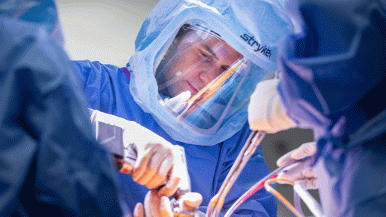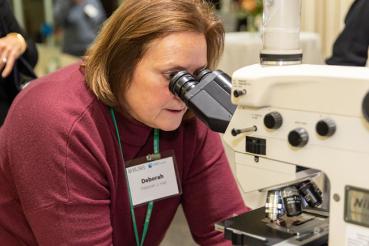Robotic-assisted technologies have existed in health care and beyond for some time, but now, this innovative tech is beginning to carve out a name for itself in orthopedic surgery, primarily, in the world of joint replacements.
At Rush, orthopedic surgeons Vasili Karas, MD, MS, and Denis Nam, MD, are using this new technology to perform joint replacement surgery. Karas and Nam have been using and studying three different types of robotic-assisted surgery in both knee replacement and hip replacement.
“There has always been an interest in using technology to our advantage for both total knee and hip replacement and partial knee replacement,” says Karas. “It’s not until the last five years, essentially, that robotic assistance has enjoyed a real growth and a real effort to try and make things better for our patients.”
Safe, reliable and accurate
Robotic-assisted surgery is an innovative method for joint replacement. Karas and Nam are still using the same well studied, tried and true implants as they do with manual surgery. So, what makes a robotic-assisted surgery different?
It’s personal.
This robotic-assisted tech uses preoperative imaging that enables the surgeon to create a 3D virtual model of the patient’s joint. The surgeons then use the model to determine the optimal size, placement and alignment of the joint implant. In some cases, the robot can also take pressure measurements of the patient’s ligaments in order to balance the knee to the patient’s personal anatomy.
“The exciting aspect and what I think is the most interesting when I speak to patients, is that we do still use tried and true implants,” says Karas. “What we are doing that is new and improved, is sharpening the accuracy and enhancing the way in which we put the implant in.”
While the components stay the same, it’s the way the components are placed that has really seen a breakthrough. Karas explains that robotic-assisted surgery is akin to upgrading from a screwdriver to a power drill, or using GPS rather than a printed map to get from point A to point B.
“Both do the job well, but this new technology does it with a higher degree of accuracy.”
Not only is this technology accurate, it’s safe and reliable as well. In fact, robotic-assisted surgery gives surgeons the ability to map out and plan most procedures before ever entering the operating room.
“We typically are planning much of the surgery before we ever make an incision, so we begin the procedure knowing what kind of implant to use, the optimal size of the implant and at the angles at which we will be making cuts,” says Karas. “This removes the decision-making from the high stress environment of an OR and helps us get through the surgery with as much information as possible.”
Customized to fit
Because no two joints are the same, there is no “one size fits all,” when it comes to joint replacement. A key benefit to the type of robotic surgery Karas and Nam are using is the fact that each procedure they perform is as unique as the patient themselves.
“The reason I’m doing robotics is so I can provide a personal level of surgery to everybody,” says Karas. “My desire to use robotics grew out of my desire to achieve a patient’s individual goals, and be as personal as I can be with patients in our clinic.”
The robotic surgery system enables surgeons to assess where the bone is in space and its relationship to the ligaments and bones around it — critical information that helps to ensure precise implant placement for optimal performance.
“We’re able to match the patient’s anatomy and give them a joint replacement that is well thought out on a personal level for each individual patient,” explains Karas.
The level of personal and tailored care doesn’t stop in the OR, though.
For instance, patients in Karas’ clinic have access to a 24/7 cellphone number that either Karas, his physician’s assistant or his nurse will pick up. The clinic also has a physical therapist who travels to patients’ homes for early post-operative therapy.
“A largest benefit of getting a joint replacement with my team actually has nothing to do with robotics at all,” says Karas. “It’s the human-to-human contact you receive before your visit and after. You’re never going to call and get an automated message. There is always going to be a person picking up the phone for you and every step of your care includes a member of my team dedicated to your success.”
More to unlock
While there are proven benefits to robotic-assisted surgery, there is still much to be learned about this emerging technology. Data on satisfaction rates, survivorship and patient reported outcomes are still being gathered and will inform future improvements.
For Karas, Nam and their teams, this is an exciting time in joint replacement surgery. Not only do they utilize these innovative procedures that are a custom fit for each patient, they also study, firsthand, how these procedures will benefit the patient.
“Rush is one of the few places in the country that is able to leverage several different implants and several different robotic technologies to find the best fit for our patients,” says Karas. “As an academic institution, one of our missions is to make orthopedics better for everyone, and that means considering all available technology and how it has the potential to help our patients.





